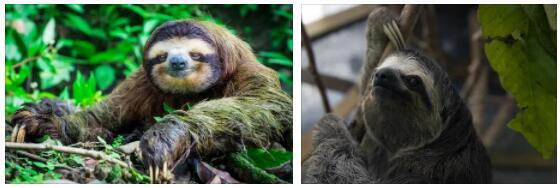Colombia is a biodiverse country
There is a huge biodiversity in Colombia. After Brazil, Colombia is the country with the most species in the world. Colombia is thus one of the 17 countries in the world, in which together 70 percent of all animal and plant species in the world can be found. It’s called a mega-diversity country. Colombia alone has around 10 percent of all species in the world. Among the countries with the most bird species, Colombia even ranks first with around 1900 species.
Colombia has a variety of landscapes such as coasts, mountains and rainforests that provide a habitat for many different animals and plants. Many species are endemic, so they only occur here. The northwesternmost province, Chocó, has the largest proportion of endemic species in the world.
52 nature parks were set up to protect nature. Because there are also environmental problems. In addition to water and air pollution, deforestation is a major problem. For example, trees are cut down so that coca can be grown, even though this is illegal, i.e. it is against the law. There is also illegal mining in many places, which is against all environmental regulations. Elsewhere you want to win land for agriculture or the wood is felled to sell. Many species are threatened with extinction as a result.
Who crawls, bounces and flies in Colombia?
A multitude of animal species also live in the diverse landscapes of Colombia. Spectacled bears and many species of possum such as the southern opossum are part of it.
The Andean Makibear feels at home in the Andes. It wasn’t discovered until 2006. It lives in the trees and is nocturnal. The Tapeti, a rabbit, lives in the tropical forests.
There are a total of 456 mammal species in Colombia. They also include anteaters and sloths, both of several species. Predators are for example the jaguar, the jaguarundi, the ocelot, the tiger cat and the coati.
Monkeys come in more than 30 species. These include the black-backed tamarin, the red uakari, the Colombian woolly monkey, and the Lucifer jumper.
Four out of five tapir species are native to Colombia. The Kabomani tapir was only discovered in 2013.
1900 species of birds flutter through Colombia
Colombia is home to 1900 species of birds – more than any other country in the world. These include, for example, the now rare yellow-headed parakeet, which relies on the Quindio wax palm as a habitat in which it breeds. The green jay and the leek arassari, a type of toucan, also feel at home on the mountain slopes. The Andean condor occurs occasionally. The scavenger is one of the largest birds in the world. The Andean cliff bird is strikingly orange and has a thick feather comb on its head.
And more animals!
The reptiles include the crocodiles, lizards and turtles, which are also found in many different species. There are 222 species of snakes alone!
The terrible poison dart frog already has a terrifying name. It is actually considered to be one of the most poisonous animals in the world and the most poisonous species of frog. The Chocó Indians used the poison for their blowguns. Incidentally, in captivity the frogs lose their toxicity. But you still don’t want to have it at home, do you?
What is growing in Colombia?
More than 40,000 plant species have been found in Colombia so far. Large parts of the country are covered with tropical rainforest. The biodiversity is always particularly great there. Orchids, bromeliads, lianas and mosses grow on the trees. Ferns grow in the undergrowth. Carnivorous plants can be found in a variety of species, such as water hoses, fatty herbs, and sundew.
The orchid Cattleya trianae, also known as the may flower, has been named the national flower of Colombia. Orchids occur in a total of 3500 species. The Quindio wax palm is considered the national tree. It only grows in a certain valley in the Colombian Andes (in the province of Quindío) at an altitude between 2000 and 3000 meters. It can grow up to 50 meters high. Alexander von Humboldt discovered them in 1801.
The páramos also have a special vegetation. Espeletia bushes (frailejones) and other rosette plants grow here. They are so named because they form rosettes. You can see this in the picture on the right.
The Puya plants are typical of the mountains of Colombia and also in the Páramo. They belong to the bromeliads, but do not grow on trees like many species, but on the ground. The leaves are in rosettes. From these a high inflorescence grows in the middle after many years. Most species die after the first flowering. Many endemic species can be found in Colombia that are unique to them.
What is a páramo?
Páramo is the name given to a landscape that can be found in the mountains from around 3000 meters altitude and where it is quite humid. Besides, it’s cool. This combination then creates certain plant shapes. The páramo is particularly typical for the Andes of South America. Typical are grasses that grow in clumps and rosettes like Espeletia. Trees no longer grow in the páramo and shrubs only in low habit.
In the Amazon region, the giant Amazon water lily grows in shallow waters. It forms leaves up to three meters in diameter that even a small child can carry. Many species of heliconia are found in the rainforest and in the cloud forest higher up. They are also called lobster claws because of their striking flowers. Passion flowers also form pretty flowers.
